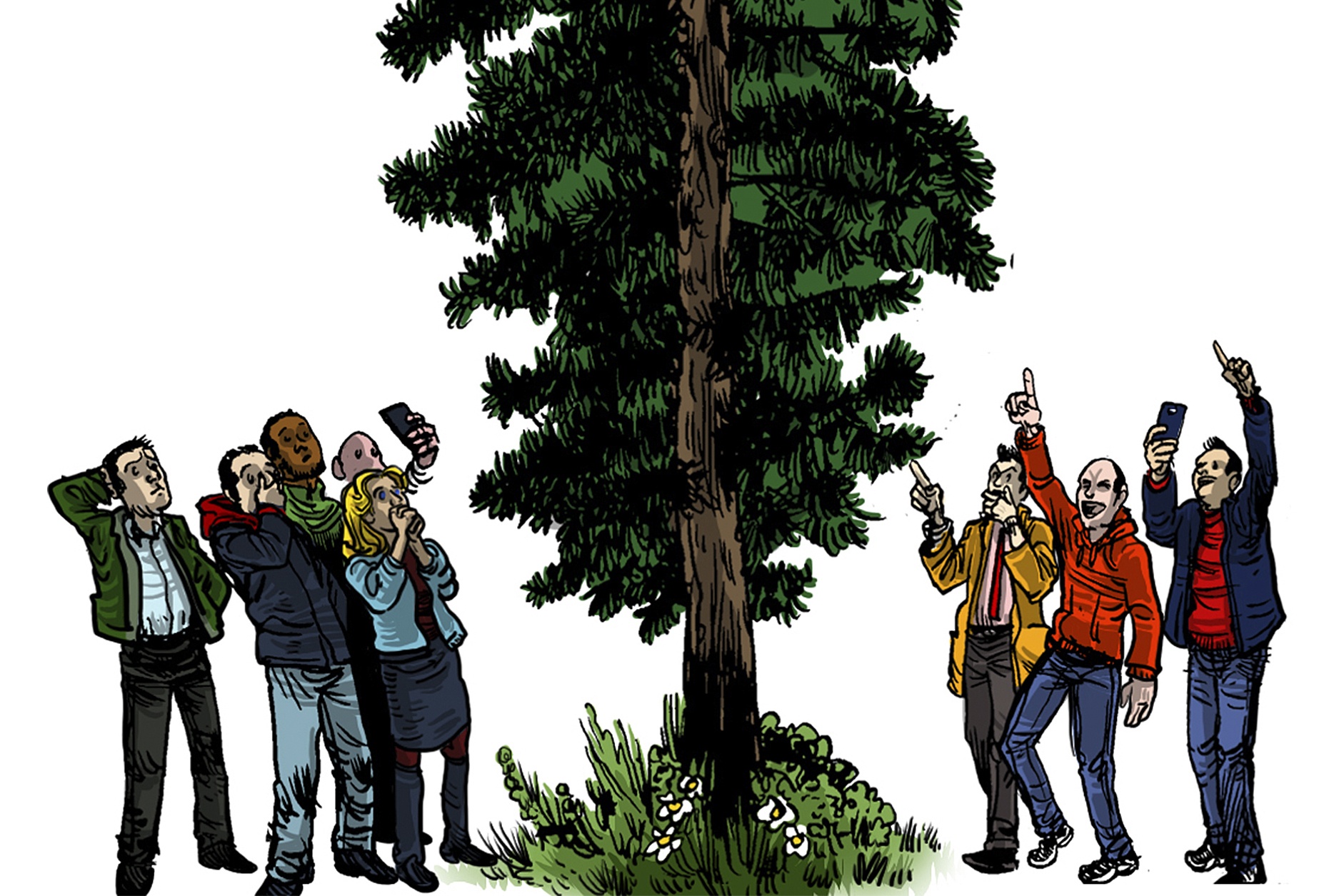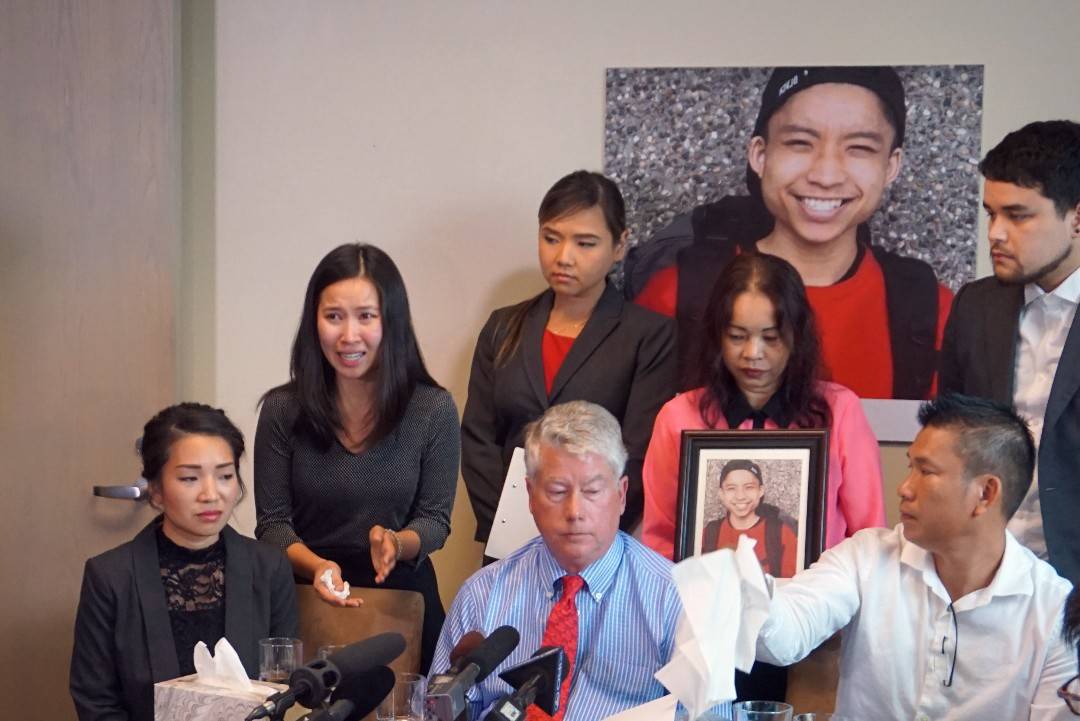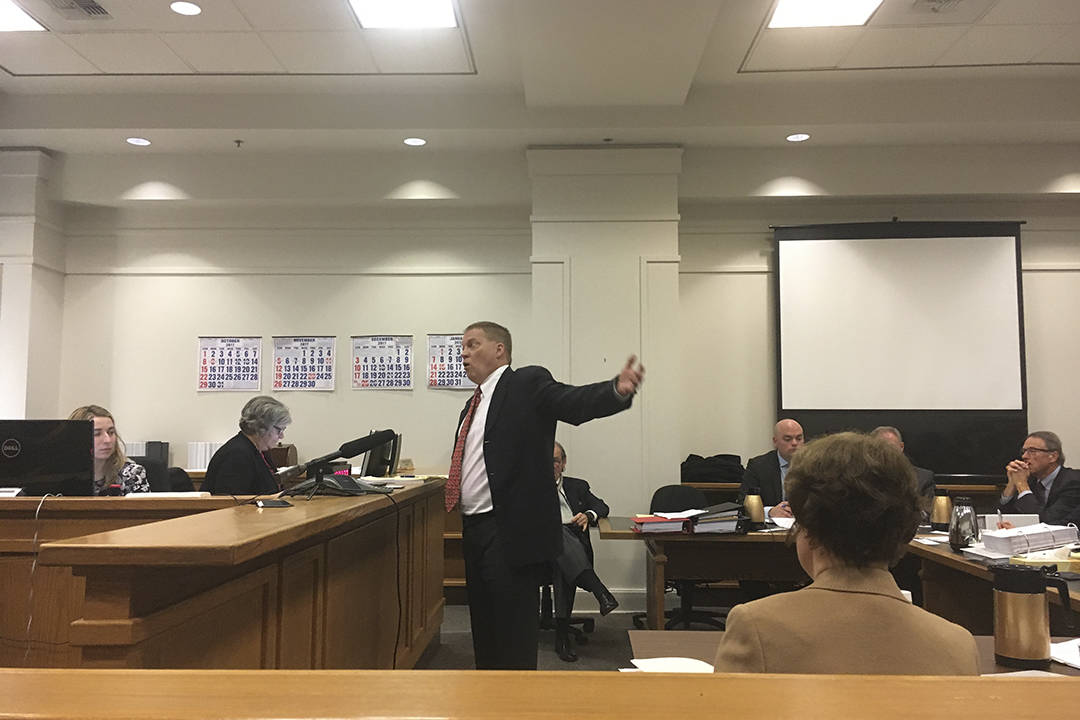Cody Lee Miller grew up in Alaska, and as a boy was accustomed to the personal space that that giant state affords a person. He’s said he liked to roam the outdoors, fished in the Bering Sea, and claims to have made an appearance on The Deadliest Catch.
But in 2016, Miller’s life unfolded in a reality-TV drama of a different sort. Specifically, Cody Lee Miller climbed a tree in downtown in Seattle in March, sparking a 25-hour standoff that was live-streamed by television stations and started an intense, if fleeting, debate about how mental health is depicted in the media. Some laughed, others scolded them for laughing, then most tuned out once Miller was out of the tree and in custody. But as it turned out, Miller’s case still had lessons to teach. In short, it displayed both the huge weaknesses and elusive strengths that exist in the way we handle mental illness in America today.
According to court records, Miller’s mother first became concerned with her son’s mental health six years ago, when he was about 23 and she found a knife in his bed. He told her the knife was needed for protection, but didn’t say who was after him. He complained of an “evil presence” in the house, and called the fire department to report a gas leak when there was none.
Unable to deal with her son’s deteriorating mental state, she sent him to Oregon to live with his grandmother, she later told KUOW. But there, things only grew worse for Miller. Court records state he feared the Illuminati were after him, and at one point he ran 30 miles barefoot, leaving his soles raw and bleeding. His mother told KUOW his grandmother eventually filed a restraining order against him due to threats he made, essentially making him homeless.
As his mental health clearly broke down, both families in Alaska and Oregon struggled to find treatment for Miller. Court documents and family testimony don’t give a clear answer as to why proper care was elusive for him. But it’s terribly typical. In the United States, fewer than half the adults with diagnosable mental disorders get adequate treatment, for reasons ranging from lack of insurance coverage to the patient’s refusal to undergo treatment.
Often, the shortcomings in America’s mental-health care are made up for by the criminal-justice system. According to a recent Urban Institute report, an estimated 56 percent of state prisoners, 45 percent of federal prisoners, and 64 percent of jail inmates have a mental-health problem. That was the case with Miller. As his behavior grew more erratic, he was almost constantly in trouble with the law. Typically, he’d get locked up, fined, and then turned out to repeat the process. As his mother would later write in an e-mail to police: “He has been put in jail many times with no medical help and then is let out on the streets.”
As he cycled through the system in Oregon, court records show, he was at times flagged for mental-health issues. As recently as February 12, he was ordered by a court to undergo a mental-health evaluation after making suicidal comments upon leaving a jail. However, it did little good. He was released again, and soon thereafter headed north to Seattle to join the thousands of other homeless people on the streets.
In mid-March, Seattle police contacted him for violating the city’s sit-and-lie ordinance—the controversial (and self-explanatory) anti-homeless law that bans people from sitting or lying down in public right-of-ways—in front of a Starbucks on East Pike Street. Police say the interaction became an attempted “suicide-by-cop” incident when Miller “threatened to reach for his knife to fight with police, stating he wasn’t sure if today was the day he was going to die.” About a week later, he was seen sleeping on a chair that had been left out on the sidewalk on Capitol Hill. A passerby, unaware of Miller’s mental state, found some innocent humor at the sight of a free spirit luxuriating in the waste of others. He took a photo and would soon post it on social media.
By that time, Miller was a gaunt 6´2˝ and 160 pounds. He had a large beard and wild hair. His possessions amounted to the clothes on his back and a backpack with a sleeping bag in it. Police would later give the backpack and sleeping bag the precise monetary value of “none.” A few days after he was seen on Capitol Hill, on March 22, Miller headed downtown and, in what he would later tell a counselor was a “cry for help,” climbed up a 80-foot sequoia at Fourth and Stewart. He threw an apple and hit a woman in the leg, which prompted her to find a cop and demand he be arrested. He continued to throw pine cones and metal support beams for Christmas lights at police and rescue workers, forestalling his removal from the tree for more that 24 hours.
Miller’s ordeal followed a now-predictable arc. As word of his tree-climbing spread, he was given a Twitter hashtag (#manintree), and would-be keyboard comedians raced to see who could be the most adroit commentator on the issue. As the story went viral across the globe, a backlash formed by people who noted Miller was clearly mentally ill, and thus should clearly not be the subject of jokes and mockery.
When he was finally removed and taken into custody, he was charged with two felonies. Citing the fact that one of the pine cones Miller threw hit an officer in the left ear and cut her “outer earlobe area,” prosecutors charged him with assault in the third degree. Then, with the help of a city arborist, prosecutors determined that the tree he climbed had been worth $51,700 before he broke several large branches off it, and $43,900 after the branches were broken. Causing more than $5,000 damage to property is grounds for felony malicious mischief in the first degree, and so he was charged.
He was assigned a lawyer, John Hicks.
By the time Hicks took on his client, Miller’s tree-climbing, which had snarled traffic and dominated social media, was well known. Also known, through media interviews with his mother, was the fact that he suffered from untreated mental illness. So Hicks was dismayed when Miller was brought into court strapped into what he calls “a Hannibal Lecter chair.”
“I’ve only had three clients arrive to court that way,” Hicks tells Seattle Weekly. “One was a serial killer [DeWayne Lee Harris] and the other was Curtis Thompson, if you remember him.” [Thompson, a convicted rapist and murderer, is serving life in prison.] “Personally, I don’t think he should have ever been arrested. What the police should have done is just taken this guy straight to Harborview. … What he did was piss off a bunch of cops.”
Miller, too, seemed to think the charges were unwarranted. According to one witness in the jail, he said the phrase “I got arrested for climbing a fucking tree” 30-some times in a row under questioning.
Still, for those who loved him, his arrest held some promise that he would finally get the care he needed. “I have tried many times to get him help,” his mother wrote in an e-mail to the court. ”I am asking the judge [to] sentence him to some kind of facility that can get him well instead of always just running him through the system. I am begging that he gets in a program and on meds so he can live a normal life.” It was unclear, at first, whether that wish would be granted, or if he would just be run through the system once again.
Despite the bizarre behavior displayed in his initial crime, and his continued strange behavior in King County Jail in downtown Seattle, some experts were skeptical that Miller had any kind of diagnosable mental illness.
On April 4, 11 days after he was arrested, a clinical assessment of Miller found he “did not present with any symptoms of a thought disorder.” Rather, the evaluator determined, his crimes and subsequent behavior could be attributed to a “free-spirit lifestyle.” On April 12, 20 days after his arrest, Miller was observed yelling at staff and stacking fecal matter by his cell door, which led an evaluator to allow he may have “antisocial traits.” Still, when he requested a transfer to Western State Hospital a week later, an evaluator concluded it “does not appear that this young man suffers from a major mental illness.” And yet again, on April 23, Miller was deemed to have “no overt signs” of major mental illness.
Finally, on May 17, nearly two months after he was removed from the tree, Cody Lee Miller was transferred to Western State Hospital to undergo a competency evaluation to stand trial. In his intake interview, he denied having mental illness, but that night was observed “talking to air” about someone “fucking [with] and kidnapping him,” according to records. He was interviewed by state psychologist David Olegar on May 26. He told Olegar and his lawyer John Hicks: “I told them the same thing in the tree. Leave me alone; I’m fine. Go away!” On May 31, Olegar filed paperwork with the state saying it was his opinion Miller suffered from paranoid schizophrenia and was not competent to stand trial.
In cases where a defendant’s mental state does not allow him to assist in his own defense, a judge can order the involuntary administration of drugs. On June 13, a judge ordered that Miller be given a regular dosage of Olazapine, an antipsychotic. “Important governmental interests are at stake,” the judge ruled. “Involuntary medication will significantly further the … state interests of the need to bring a defendant to trial.”
Miller remained committed at Western State. No longer confined to a solitary cell in the King County jail, he was allowed to mingle with other patients. That’s healthy for the patients, Hicks says: “You have to allow these guys some leeway to walk around.” But it comes with some peril. At some point—before July 3, though the records are unclear on exactly when—Miller directed a racial slur at some other patients. The patients attacked Miller and broke his jaw, requiring a doctor to wire it shut. Miller also commented to several peers that he wanted to kill a cop.
Slowly, though, the drugs proved effective. Over the course of July, staff reported that his behavior was improved. He shaved his beard and was polite to staff. He made good with the people who had attacked him. “Despite the fact that the peers he had directed racial slurs toward assaulted him, breaking his jaw, he apologized to them for the insults,” an evaluator wrote.
By August 24, Olegar, the state psychologist, ruled that Miller was competent to stand trial—though he also found that forced medication was still needed since Miller expressed doubt that the drugs did anything.
With felony charges still pending, Hicks and the King County Prosecutor’s Office began the process of diverting Miller to the King County Regional Mental Health Court.
Manka Dhingra, senior deputy prosecuting attorney with King County and the chair of the therapeutic alternative unit that oversees mental health and veterans courts, says Miller is a perfect example of a person the court was set up nearly 20 years ago to help.
The King County Regional Mental Health Court was only the second of its kind created in the country. It was first called to order in February 1999, after a task force investigated whether mentally ill patients could be better handled by the system. The task force found that under normal circumstances, the courts were direly unequipped to handle the mentally ill. “With little extra attention paid to individual defendants as cases moved through a high-volume court system, mentally ill defendants whose mental illness may have caused their involvement in criminal justice were simply moved through the court process like every one else… . As a result of normal procedures, mentally ill defendants and offenders often reoffended and were recycled through the system again and again,” a federal report on the King County court later said.
This standard operating procedure had had a tragic result in August 1997, when a misdemeanor defendant deemed unfit to stand trial in Seattle Municipal Court was turned out on the streets and soon thereafter murdered retired fireman Stanley Stevenson as he walked to his car following a Mariners game. The murder prompted the task force and, ultimately, the mental-health court. The defendant in the case, Dan Van Ho, had a long record of run-ins with the law, many related to his mental illness.
Under mental-health court proceedings, defendants plead guilty to their charges, and in exchange are subjected to “conditions of treatment” for up to 24 months of supervision. During the time of supervision, the courts can compel patients to take medication, live in sober houses, and other terms. If a defendant holds up their end of the bargain, charges can be dropped. Today, the regional mental-health court handles about 200 cases a year, overseen by one judge, three prosecuting attorneys, three defense attorneys, and support staff.
Dhingra says her office had flagged Miller’s case early as a potential mental-health court case. However, since the court is voluntary, defendants must be competent before they can agree to submit to the terms of the court. Once Miller was deemed competent, the state was willing to reduce his felony charges to misdemeanor charges in order for him to be eligible for mental-health court; Dhingra says about 55 percent of their cases are reduced felony cases.
Miller was sentenced to two years of supervision; he is now living in “supportive housing” in King County, and meeting regularly with mental-health counselors, probation officers, and the judge. Dhingra says it’s that kind of accountability that works for people in the court, and it’s the lack of it that leads to so many people coming through the criminal-justice system to begin with.
“It’s that accountability and structure. He comes to court even when he’s doing well; he develops a relationship with the judge. If things go bad, he can talk about it. So we can catch things early rather than not catching it until things hit rock bottom,” she says. “I would love to see someone drive mental-health court out of business; [to] say, hey, we’re not filing charges here. But until people get involved in the criminal-justice system, there’s no accountability. If they miss an appointment, there’s no follow-up, no one checking up. No one saying, ‘We care about how you’re doing.’ We definitely need to ramp up those services.”
As such, Miller’s case displays the full spectrum of mental-health care in the United States today. As his family has attested, he shows how difficult it is to get adequate treatment for the mentally ill, even when they start to get in trouble with the law. But it also suggests some progress has been made, and why the efforts are worth it in the end.
“I am happy to report he’s doing extremely well,” Hicks says. “Once you get to know him, he’s one of the nicest people you’ll ever meet. I was privileged to represent him.”
dperson@seattleweekly.com








